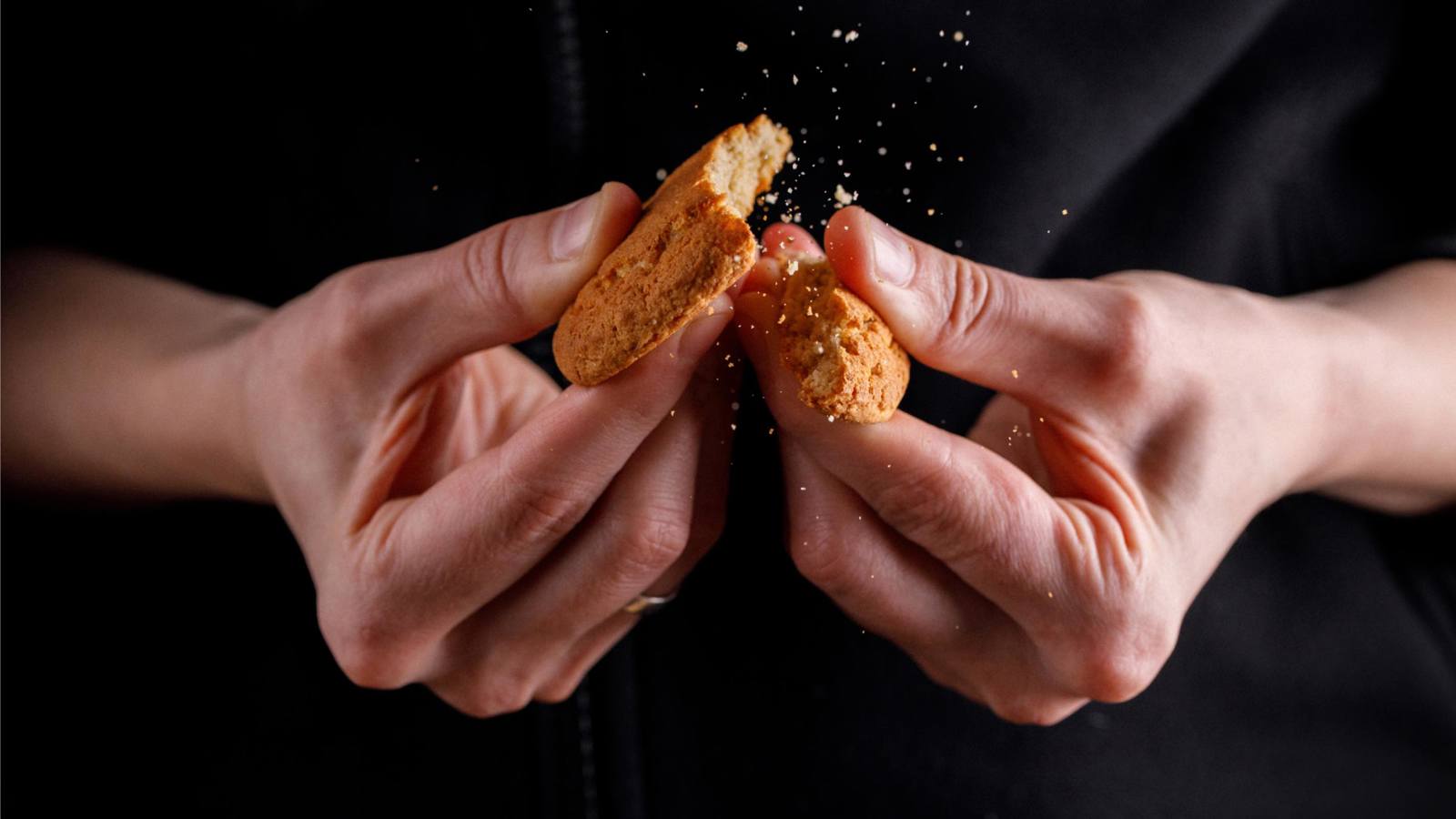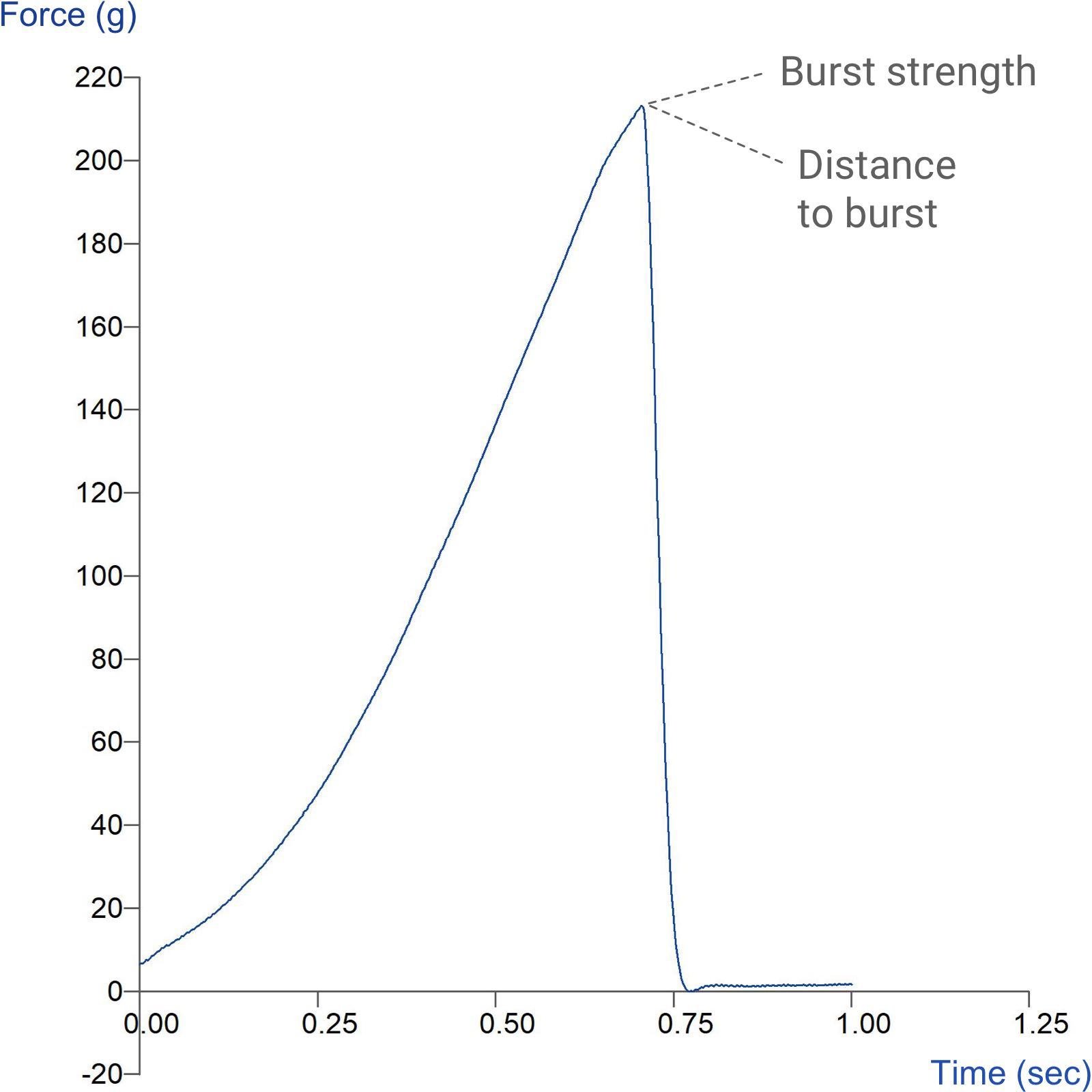How to measure fracturability/brittleness

Fracturability/brittleness: definition and importance
Fracturability/brittleness refers to a material’s tendency to fracture, crack, crumble, or shatter under the application of a relatively small amount of force or impact. Both terms are closely related, with fracturability referring to the force required to initiate a fracture or break, and brittleness describing how a material behaves when it breaks — specifically, how little deformation occurs before it fractures. Brittle materials show a quick, clean break with little warning or flexure. A material may be highly fracturable but not necessarily brittle (e.g., it might bend before breaking).
In texture analysis/physical property testing, these properties are critical for understanding the mechanical behaviour of materials, particularly in industries such as food (e.g., crackers, biscuits), manufacturing (e.g., plastics, metals), and packaging materials (e.g., films, cartons). Products with high hardness and low cohesiveness, such as baked goods and dry snacks, commonly exhibit brittleness. Brittle materials tend to fracture rather than deform when subjected to stress, often producing a snapping sound. Understanding the fracturability of materials is crucial in industries like food processing and materials testing to ensure product quality and optimise material properties.
Further example applications of fracturability and brittleness testing
Fracturability and brittleness testing using a Texture Analyser is valuable in industries like food processing, materials science, and manufacturing. Below are key applications:
- Food product brittleness testing: Evaluating the brittleness of food items like crackers and cookies by measuring the force required to break them which will ensure the desired crispness or crunchiness. In some chocolates, fracturability is desired for a crisp break. A sharp rise in force followed by a quick drop in the graph shows that the chocolate has fractured cleanly. Dry pasta, such as spaghetti, is also brittle, fracturing quickly when bent beyond a small deformation point. The force vs distance graph for brittle materials like dry pasta shows a high, sharp peak followed by an immediate drop. Potato chips also demonstrate brittleness, as they shatter or fracture with minimal bending. A force vs distance graph for a chip would show a sharp, high peak with a quick drop.
- Pharmaceutical tablet fracturability: Assessing the fracturability of tablets to ensure they are easy to break for dose adjustments by measuring the force needed to split them.
- Candy and confectionery fracture analysis: Testing the brittleness of candies like brittle toffees and hard sweets by measuring the force required to fracture them.
- Ceramic/glass material fracture testing: Evaluating the fracture strength and brittleness of ceramics used in manufacturing by measuring the force and/or flexural distance needed to break a ceramic tile. Glass is a classic example of a brittle material. It resists force up to a certain point and then shatters suddenly without any plastic deformation.
- Brittle polymer and plastic testing: Testing the brittleness of polymer and plastic materials by measuring the force needed to fracture a brittle plastic sample determining flexibility versus brittleness in product design.
- Brittle coating or glaze testing: Assessing the brittleness of coatings, glazes, or enamels applied to materials by measuring the force required to fracture a brittle enamel coating.
- Pharmaceutical capsule fracturability: Assessing the fracturability of pharmaceutical capsules to ensure they can be easily opened by consumers by measuring the force needed to break them open.
In these examples, a Texture Analyser applies controlled forces/distances to measure the fracturability and brittleness of various materials, ensuring product development, quality control, and material characterisation.
Typical probe/attachment used for measurement
In a typical fracturability/brittleness measurement test, a sample is supported underneath (Three Point Bend Rig/Crisp Fracture Support Rig), at each end (Spaghetti Flexure Rig), around its perimeter (Film Support Rig) or at one end (Lipstick Cantilever Rig) and flexed until it is broken as the Texture Analyser records the force and distance to cause failure.
It is also common to compress, penetrate or shear through a sample and measure its brittle failure.
Typical comparison of samples
Flexure test
When measuring fracturability/brittleness this way, the force vs distance/time graph typically shows an obvious peak with a sharp drop in force representing the amount of force and distance needed cause sample failure.
Compression/penetration test
When measuring fracturability/brittleness this way, the force vs distance/time graph typically shows an curve with multiple undulations/peaks within the graph as the sample fails. From the graph you can observe/obtain the following:
How to interpret the Texture Analyser graph
From the usually triangular-shaped graph from a flexure graph to a multi-peak curve of a compression/penetration test you can observe/obtain the following:
- Rupture point
- Crispness
- Fracturability
- Crunchiness
- Brittleness
- Fracture strength
- Fracture distance
- Work of failure
- Breaking strength
 Typical curve indicating key analysis points of a flexure test
Typical curve indicating key analysis points of a flexure test
 Typical curve indicating key analysis points of a compression/penetration test
Typical curve indicating key analysis points of a compression/penetration test
A full explanation of these curves and their analysis can be accessed within Exponent Connect software. Existing Exponent users can upgrade to Exponent Connect specification.
Below is a video example of how we can help you understand curve analysis for an example property.
Key factors affecting fracturability/brittleness measurement
- Moisture content: The amount of water in a sample can greatly affect its fracturability and brittleness.
- Temperature: The temperature of the sample during testing can influence its mechanical properties, affecting fracture behaviour.
- Test speed: The rate at which force is applied during the test can influence the measured fracturability and brittleness, especially for viscoelastic materials.
- Sample geometry: The shape and size of the sample can affect how stress is distributed and how fractures propagate.
- Environmental conditions: Humidity and temperature of the testing environment can affect the sample's properties.
- Sample preparation: Consistency in sample preparation and any pre-test conditioning is crucial for reproducible results.
Collecting additional measurements during your test

Acoustic Envelope Detector
The Acoustic Envelope Detector can by employed for any material which produces an audible noise when tested as it captures another dimension (i.e. sound) during the test which can also be analysed and used as a measured product feature.

Video Capture and Synchronisation System
The Video Capture and Synchronisation System can by employed to record and replay any test but is particularly suited to those tests that occur quickly, contain a fracture event or can easily be missed with the human eye. Data can be shared and viewed by colleagues or used as an educational tool to teach about the features of a product’s breakdown.
Optimising fracturability/brittleness measurement and analysis: The Stable Micro Systems advantage
The Stable Micro Systems Texture Analyser stands out in optimising fracturability and brittleness measurements through its comprehensive approach and specialised features. Equipped with dedicated tools like the Three Point Bend Rig and Crisp Fracture Support Rig, it precisely quantifies multiple properties including rupture point, crispness, fracturability, and work of failure.
Accurate measurement of fracturability/brittleness requires precise collection of events that occur quickly producing fluctuating curves, with multiple peaks and troughs. Exponent Connect software enhances accuracy by capturing data at 2000 points per second, providing highly detailed graphs for in-depth analysis.
In contrast, lower data collection rates, often found in alternative equipment, can result in compromised accuracy and missed information, impacting the reliability of the results. The Texture Analyser can also incorporate acoustic analysis for multi-dimensional insights. Its versatility allows for testing a wide range of materials, from baked goods to industrial products.
Backed by Stable Micro Systems' expertise in method development and data interpretation, makes it the ideal choice for industries seeking to refine product formulations and maintain quality standards in fracturability and brittleness testing.
A choice of dedicated attachments capturing data at 2000 points per second for fast occurring fracture events.
Comprehensive analysis of fluctuating curves, with numerous peaks and troughs to quantify multiple parameters.
Ability to additionally measure sound (using an Acoustic Envelope Detector) and video for fast occurring fracture events.
Adjust settings to simulate real-world usage conditions to collect detailed force-time-distance profiles.
If you need help with your fracturability measurement, we offer unrivalled support.
Be guided through the steps to successful testing and analysis of fracturability / brittleness.












